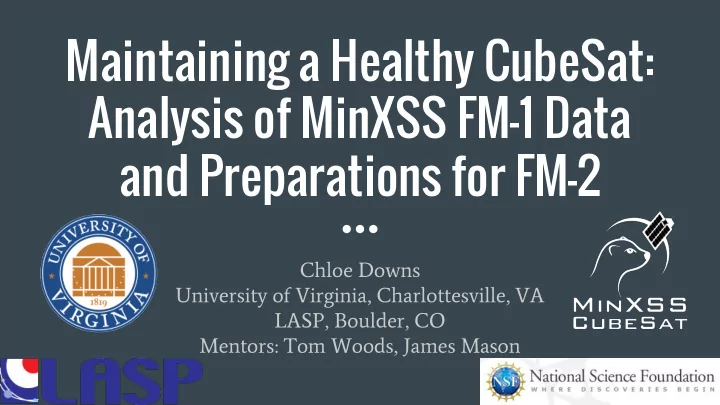

Maintaining a Healthy CubeSat: Analysis of MinXSS FM-1 Data and Preparations for FM-2 Chloe Downs University of Virginia, Charlottesville, VA LASP, Boulder, CO Mentors: Tom Woods, James Mason
Questions I Will Answer What is MinXSS? • How well is the first MinXSS performing in orbit? • Is it within its required temperature ranges? • Is it using too much power? • How much data are we collecting from it? • Is the second MinXSS ready for flight? • 2 Photo credit: NASA
What is MinXSS? Miniature X-Ray Solar Spectrometer CubeSat • Spectrum by Tom Woods Goal is to better understand • flares/CMEs, the emission they produce, and their impact on the Earth’s upper atmosphere • Two Flight Models: FM-1 deployed May 2016; FM-2 to be launched Dec 2016 3
MinXSS Components Antenna SPS/XP X123 COMM CDH Batteries EPS Motherboard: not visible, located Image by James Mason along the back of Solar Arrays ADCS the components 4
MinXSS FM-1 Temperatures Within Their Operating Ranges 5
Temperatures Vary with Orbit Beta Angle 6
Hot and Cold Case Data: What Does it Look Like? 7
MinXSS FM-1 Models and Data Show Good Agreement 8
Hot and Cold Case Results: Everything Looks Good! Hot Case: • All 6 components are within 10 ° C, 3 of those are within 5 ° C, and 2 of those • are within 3 ° C Largest difference: -9 ° C for the Batteries • Cold Case: • All 6 components are within 10 ° C, 4 of those are within 5 ° C, and 3 of those • are within 3 ° C Largest difference: -7.2 ° C for the EPS • X123 is the the most critical component. It is within 5 ° C on the cold case and • within 3 ° C on the hot case - very good 9
Solar Arrays: Better Than They Look 10
MinXSS’s Basic Power Diagram 11
Is MinXSS Power Positive? Yes! It is critical for a satellite mission that the power produced is more than the • power consumed. In other words, is the system power positive? Difference (%) = Generated Capacity- Consumed Capacity • * 100 Generated Capacity • Generated capacity at β = 0˚ (60 minutes of sunlight) is 19.6 Whr; β = 73˚ (92 minutes of sunlight) is 30.0 Whr Mode Consume med Capac acity ity Differe renc nce, e, β = 0 ° Differe renc nce, e, β = 73 ° Science 12.9 Whr 35% 58% Safe 8.4 Whr 57% 72% Phoenix 4.1 Whr 79% 86% 12
How Much Data Are We Getting from MinXSS? How many of the requested packets do we decode? • We use a ground station on LASP’s roof and another run by Jim White in Parker, CO • The antenna was fixed on 6/24 • 63.18 % data capture rate • Lower than planned due to • unforeseen complications with antenna and overheating radio 13 Image by James Mason
Data Capture Rate Has Been Good Throughout Mission 14
I2C Bus Anomaly Most of the MinXSS voltage, current, and temperature monitors are read from • devices on a shared data bus called the I2C (Inter-Integrated Circuit). MinXSS has 14 I2C devices. • If one of I2C devices stops working then it can hang (stop) the I2C data transfers. This anomaly with the I2C bus has occurred 3 times so far, but it is not related to being in a radiation belt. MinXSS would broadcast 14 error messages every 3 seconds, making it extremely • difficult to communicate with the spacecraft (because the radio can’t talk and listen at the same time) • The only way to clear the error is to do a power reset on the spacecraft 15
Simple Fix for FM-2 Solution for FM-2: addition • of mechanical relay This solution has been • designed, built, and tested on FM-2 16 Images by Tom Woods
Closing Remarks Temperature, power, and data capture rate all bode well for FM-1 and 2 • The power reset relay is working as expected; it will have more testing during • thermal vacuum cycle testing in August • We have every reason to expect FM-1 and 2 will remain healthy for the duration of their missions 17
Questions? This work was supported by the NSF REU grant 1157020 to the University of Colorado. Additional thanks all the members of the MinXSS project. 18
Recommend
More recommend